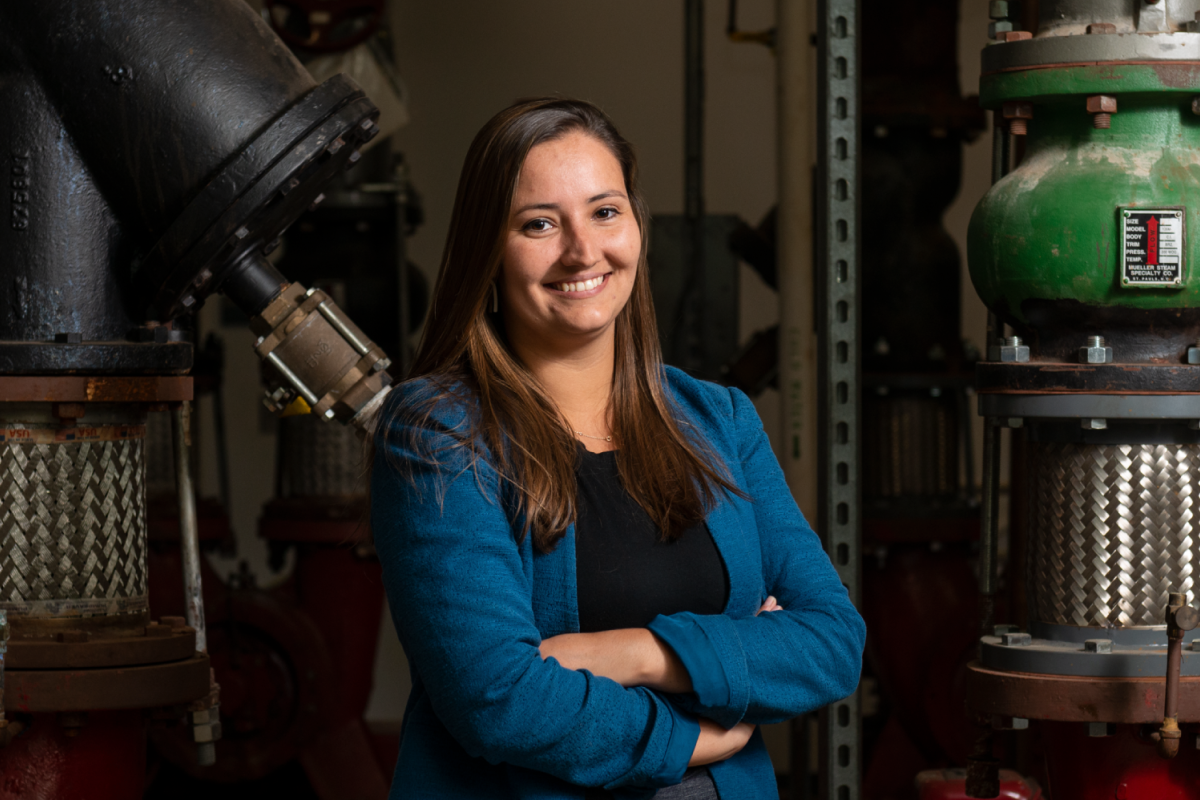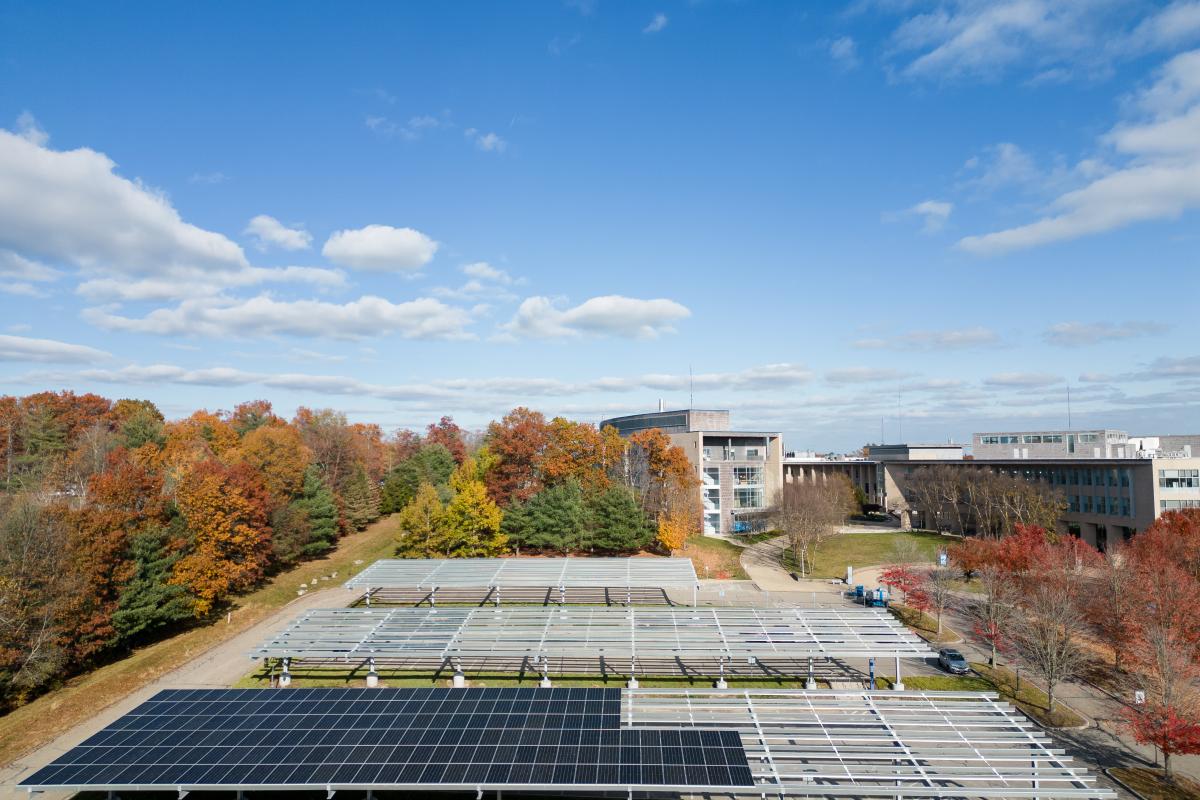STORY: New Building Design Course Addresses Olin’s Sustainability Goals
“Building Design for Climate Change Adaptation” introduces interdisciplinary perspectives of challenges and opportunities in developing energy-efficient and resilient infrastructures
In a new course “Building Design for Climate Change Adaptation,” Olin College students explore design solutions for improving the environmental performance of buildings and infrastructure in the context of climate resilience and adaptation.
The course is team-taught by Claire Rodgers, adjunct instructor as well as associate director for sustainability and campus engineering, and Gordana Herning, an instructor at Olin. The course uses Olin as a real-world example, asking students to apply what they’re learning to examine and improve the sustainability of buildings on campus.
“Building Design for Climate Change Adaptation” is part of Olin’s Living Lab effort, which is an initiative focused on using the college eco system to develop solutions for the many problems we face as people and as a planet. Olin College’s Living Lab creates innovative, sustainable education and research models that make the college experience more relevant and engaging for students while addressing real-world problems related to sustainability and beyond. Increasingly students at Olin will work on projects that have actual impact on the campus, local communities, and beyond.
With the instructors’ complementary lenses, they help students explore topics such as design for sustainability and material options and their distribution in a structure. Students learn about specific building codes and standards, such as ASCE/SEI 7, which looks at minimum design loads for occurrences like floods, atmospheric ice, and tsunamis. Students also examine sustainability guidelines like the Living Building Challenge, which advance design requirements. By connecting theoretical principles with real-world examples, class topics address engineering fundamentals and developments in professional practice.
“Our intention is not only for students to develop their analytical skills, but through their projects and interactions with practicing architects and engineers, to experience how collaborative design processes respond to the needs of society,” says Herning. “There are hazards and climate risk factors in built environments that engineers can address, and because of the complex infrastructure at Olin and in the vicinity, we can offer students access to real-world projects of various scales.”
Another benefit is the cross-disciplinary nature of the projects in question: From accessibility to carbon impact to policy, students are encouraged to adopt a variety of perspectives to consider the impact of projects from many different angles.

Many students at Olin are interested in various aspects of building and sustaining a just and flourishing world
A building project team requires many different disciplines, engagement with relevant parties in the community, and communication between everyone. In this course, we hope to illustrate some of the pathways students can engage in to create the environments and change they hope to see.
Claire Rodgers
Adjunct Instructor & Associate Director for Sustainability and Campus Engineering
Students in the course share a passion for exploring sustainable practices at the intersection of architecture, engineering, and urban design, as well as the measures for adapting the built environment to minimize the effects of climate change. Classwork includes case studies on various structures and their construction, exploration of on-campus projects such as the solar carport, tours through Olin’s building mechanical systems, and guest speakers that highlight different opportunities for engaging in sustainability work across careers in planning, design, and construction.
For their final projects, students were asked to apply the skills they learned to Olin’s built environment by considering how to retrofit an existing building or build a new one to meet stringent performance standards in alignment with Olin’s Climate Action goals. The students were also asked to consider and address the various requirements of the Department of Energy Solar Decathlon® Design Challenge, which include focus areas such as efficiency, grid interactivity, and health. One team, for example, focused on retrofitting Miller Academic Center, known as the MAC, to create more gathering spaces and decrease energy usage.
Though direct impact from projects in this course will mainly be felt on campus, Rodgers and Herning are envisioning a much greater goal with “Building Design for Climate Change Adaptation.”
“Olin is a small place, however it is important for us to do our part in addressing climate action within our own institution as well as prepare students for the challenges in addressing the complex issues the world is facing,” says Rodgers. “Through this course, we're hoping that students leave Olin feeling more prepared to engage in this work out in the world.”
“Sustainability has been a driving value of mine for my whole life, but until taking this course, I didn't truly appreciate the importance of our buildings in the renewable energy transition,” says Brooke Moss ’25. “This course ignited an interest in being part of the transition to net-zero homes: I’m applying to internships in this space and working with my family to envision an extensive energy-conscious retrofit of our 200-year-old farmhouse.”

Image of Olin's Solar Project construction in Parking Lot A. Taken by Professor of Biology and Art and Michael E. Moody Professor, Helen Donis-Keller.